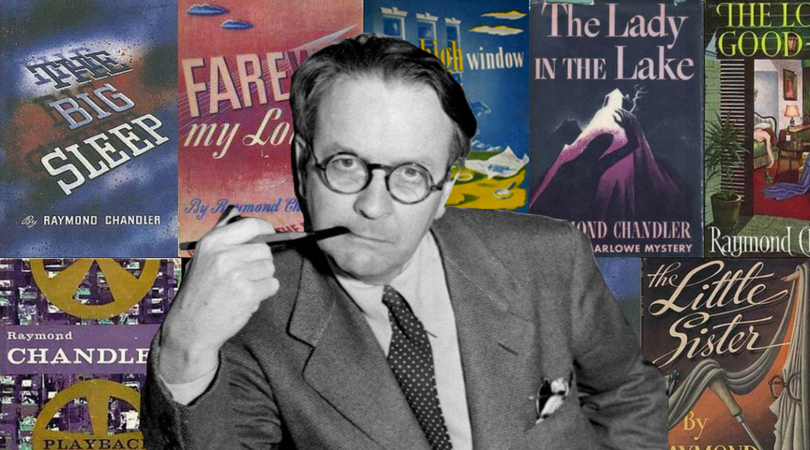
I was as hollow and empty as the spaces between stars.
Today marks the 130th anniversary of the birth of Raymond Chandler, patron saint of Los Angeles noir and perhaps the most famous crime fiction writer of all time. Each of his nine novels, from The Big Sleep (1939) to the posthumously published Playback (1953), center around iconic gumshoe Philip Marlowe—Chandler’s wisecracking, whiskey-drinking, tough-as-an-old-boot fictional private investigator so memorably portrayed on screen by (among many, many others) Humphrey Bogart, Elliot Gould, and Robert Mitchum—as he navigates the murky underbelly of the City of Angels. Our sister site CrimeReads has more fascinating Chandler content than you can shake a .32 revolver at, and to mark this auspicious anniversary we thought we’d follow their lead by bringing you the first reviews of every one of his novels.
*
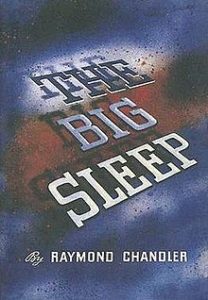
The Big Sleep (1939)
Dead men are heavier than broken hearts.
“Most of the characters in this story are tough, many of them are nasty and some of them are both. Philip Marlowe, the private detective who is both the narrator and the chief character, is hard: he has to be hard to cope with the slimy racketeers who are preying on the Sternwood family. Nor do the Sternwoods themselves, particularly the two daughters, respond to gentle treatment. Spoiled is much too mild a term to describe these two young women. Marlowe is working for $25 a day and expenses and he earns every cent of it. Indeed, because of his loyalty to his employer, he passes up golden opportunities to make much more. Before the story is done Marlowe just misses being an eyewitness to two murders and by an even narrower margin misses being a victim. The language used in this book is often vile, at times so filthy that the publishers have been compelled to resort to the dash, a device seldom employed in these unsqueamish days. As a study in depravity, the story is excellent, with Marlowe standing out as almost the only fundamentally decent person in it.”
–Isaac Anderson, The New York Times, February 12, 1939
*
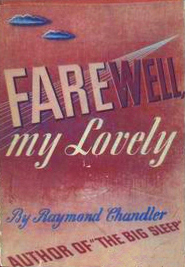
Farewell, My Lovely (1940)
It was a blonde. A blonde to make a bishop kick a hole in a stained-glass window.
“This is a tough one: superlatively tough, alcoholic, and, for all its wisecracks, ugly rather than humorous. Like many ‘swift-moving’ tales, it is sometimes confusing in its rapid succession of incidents which may or may not have an integral connection with the plot. And the actual mystery is not important. It isn’t so difficult to guess what had become of the beautiful cabaret singer Velma. The identity of the unpleasing Lindsay Marriott’s slayer has no pressing interest. The murder casually committed by that elemental giant Moose Malloy is only an episode to start the story going. No, the appeal of Farewell, My Lovely is in its toughness, which is extremely well done.
Jeanne Florian may know something or nothing about Velma, but Philip Marlowe’s questioning of that gin-soaked old woman makes as sordid a bet as you’re likely to be looking for. Beautiful Mrs. Grayle has a real place in the story, but it’s the sense of evil all about her that gives you goose-flesh. And Amthor the ‘psychic consultant’ and Sonderberg the ‘dope doctor’ are lesser figures in a novel in which no detail is left undescribed.
But the story’s ever-present theme is police corruption, seen in a murky variety. And several kinds of dreadfulness are handled with a grisly skill.”
–Isaac Anderson, The New York Times, November 17, 1940
*
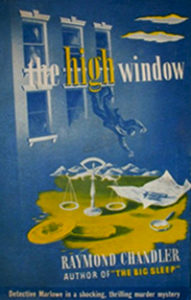
The High Window (1942)
She had eyes like strange sins.
“There is good reading in the High Window. The characters are drawn with considerable skill, notably that of Mrs. Elizabeth Bright Murdock who engages Philip Marlowe to to discover a missing doubloon and a missing but undesired daughter-in-law. Mrs. Murdock drinks port for her asthma—a strong-minded old lady who keeps her own counsel and gives the unfortunate Marlowe very little to work upon. He has however, the nose of the sleuth and as much courage as it takes to do sleuthing in some parts of southern California. There is a rather sad little female, Mrs. Murdock’s secretary, who comes and goes and whom Marlowe finally restores to her own people, feeling as he says, ‘as though I had written a poem and it was very good and I had lost it and would never remember it again.’ There are enough passages like this to raise this book to a level about the average, but there is nothing poetic about the murders, or about what had happened years and years before—at the High Window.”
–The Montreal Gazette, September 26, 1942
*
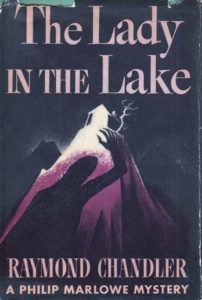
The Lady in the Lake (1943)
I’m all done with hating you. It’s all washed out of me.
I hate people hard, but I don’t hate them very long.
“Terrific action that packs a wallop vies with emotional passion to bring intense suspense in The Lady in the Lake. Private investigator Marlowe solves a mystery involving four particularly shocking murders.
…
“How Marlowe probed into these strange murders, becomes closely associated with them though circumstantial evidence, makes for a thriller of the first order.
There are many interesting characters throughout this excellent piece of detective fiction. There is the beautiful and exotic secretary to Kingsley. There is the sheriff at Little Fawn Lake who is wise beyond his looks. There is the ugly grading detective DeGarmo who manages to cause Marlow plenty of trouble. There is a curious sob-sister newspaper woman. All of the author’s characters are tremendously realistic in portrayal.
Raymond Chandler is a writer extremely difficult to define. His is an originality one cannot simply dismiss as a combination of Dashiell Hammett and James Cain … There is beauty of expression, witty dialogue, development of character, tremendous forcefulness, fast action, and thrills aplenty in The Last in the Lake. A thoroughly adult mystery to keep you awake long after bedtime.”
–Ray Gould, The Montgomery Advertiser, December 5, 1943
*
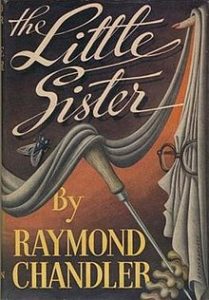
The Little Sister (1949)
She smelled the way the Taj Mahal looks by moonlight.
“Movie stars, gangsters, and a poor little girl from Kansas whose mother reared a psychopathic son mix glibly in Raymond Chandler’s newest whodunit, The Little Sister.
Philip Marlowe as Chandler’s private eye is a smooth talking, whiskey-drinking character who tosses suggestive suggestions and 38 revolvers around with equal aplomb.
In a search for the little sister’s big brother, who gets himself lost in California, and in succession mixed up with a mob, Marlowe finds a series of corpses, lands in jail, and is propositioned by a movie star and a swift-talking, easy-on-the-eyes brunette.
If you’re a Marlow fan, you’ll like The Little Sister. We’re old-fashioned—we like a mystery where no matter how many bodies are found, the culprit gets his due, and everyone—still alive—lives after all. Maybe Perry Mason is our meat, after all.”
–The Arizona Republic, October 2, 1949
*

The Long Goodbye (1953)
The French have a phrase for it. The bastards have a phrase for everything and they are always right.
To say goodbye is to die a little.
“Raymond Chandler, generally acknowledged as the foremost creator of hard-boiled detective stories after Dashiell Hammett, has written regrettably little of late. After a large number of first-rate novelettes in the Nineteen Thirties and four distinguished novels, 1939-43, he has produced only two novels in the past eleven years. The first of these, The Little Sister (1949), I found badly disappointing though some critics rated it high among Chandler items: but the newest, The Long Goodbye, (Houghton Mifflin, $3), more than assuages the disappointment and makes one wish that Chandlers were as frequent as Gardners.
This one is rather off the hard-beaten path of Chandler-tana. It’s about private detective Philip Marlowe, of course, as are all Chandler novels, but both Marlowe and his creator seem to have mellowed somewhat in fifteen years. The plot deals relatively little with the professional criminal classes, but rather with the tensions—emotional, psychological and fundamental of the upper middle class.
On the whole, despite occasional outbursts of violence, it’s a moody, brooding book, in which Marlowe is less a detective than a disturbed man of 42 on a quest for some evidence of truth and humanity. The dialogue is as vividly overheated as ever, the plot is clearly constructed and surprisingly resolved, and the book is rich in many sharp glimpses of minor characters and scenes. Perhaps the longest private-eye novel ever written (over 125,000 words!). It is also one of the best—and may well attract readers who normally shun even the leaders in the field.”
–Anthony Boucher, The New York Times, April 25, 1954
*

Playback (1959)
I’m not a young man. I’m old, tired and full of no coffee.
“Chandler fans will know what to expect: a cool style, beautiful dames, some gratuitous philosophizing and, of course, Philip Marlow.
This time he starts on a standard tail job. He has to keep his eye on a redhead who is fleeing something mysterious. Marlowe’s efforts to discover her identity and the reason for her fear provide the story As a plot it is somewhat shaky but there are other attractions.
There are vivid characters—the rich, distinguished crook Brandon, the platinum-blond secretary Miss Vermilyea; Javonen, ex-military intelligence, and seedy private eye from Kansas, Noble, who might have lurched out of an early Graham Greene story.
Chandler’s virtues are competence and clarity He is so sure of his trade that he carries us along effortlessly from start to finish.
…
The redhead, Betty Mayfield, is the most unsatisfactory aspect of the book. She has to fit in with the improbable plot and she remains improbable . Possibly the author was trying to draw a character more complete than the others. However, she is not so much complex as confused.
But most Chandler enthusiasts will read Playback to see Philip Marlowe once again. He is unchanged, hard on the outside, soft in the center like a chocolate cream, strictly moral about money but sexually an opportunist, a kindly fellow, a good guy, chivalrous knight who deals with modern life as his fans would like to.”
–The Age, April 11, 1959
*
Hungry for more Raymond Chandler content?
Check out these lists of classic covers of The Big Sleep and The Long Goodbye, ranked.

